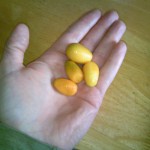Kumquats – A Super Shot of Vitamin C
 One of our greatest challenges is getting the right amount of vitamins and nutrients in our modern diet. A few fruits and berries stand out above the rest when it comes to delivering the goods. Kumquats, a type of Chinese citrus fruit, is one such fruit.
One of our greatest challenges is getting the right amount of vitamins and nutrients in our modern diet. A few fruits and berries stand out above the rest when it comes to delivering the goods. Kumquats, a type of Chinese citrus fruit, is one such fruit.
Kumquats are tiny, grape-shaped “mini-oranges” that are eaten skin and all. The latter part of that sentence is what makes kumquats such a bonus for us. All fruit enjoys antioxidants in their skins, but most of us don’t eat the skins of citrus fruits. That means that most of the antioxidant benefits are lost. Literally, we throw the best part of the fruit in the garbage most of the time.
Kumquats have a fleshy skin that is more subtle in flavour than most citrus fruits. This makes them perfect to eat whole. Moreover, the seeds of kumquats are non-toxic to humans and tend to be very soft, so chewing them or swallowing them whole poses no health hazard. The increased fibre from eating the skins and seeds is a coup for our diets that are typically suffering from a lack of fibre.
The best thing, however, is the antioxidant 1-2 punch that this fruit offers. Not only do we get the Vitamin C and other nutrients from the pulp and juice, we get the additional, front-line Vitamin C from the skin itself. Score 1 for antioxidants!
I’ve also gotten into the habit of eating the skins of thin-skinned mandarin oranges. It’s a bit of an acquired taste, I admit, but the benefit of getting the additional antioxidants makes it worth it to me.
Skin is our front-line defence against oxidation in our environment. Fruit is no exception here, and the thinner the skin of the fruit, the higher the concentration of antioxidants in the skin. So-called cold-climate fruits offer the best combination of high antioxidant concentrations and lower amounts of sugar. Tropical fruits, as good as they taste, tend to have inedible skins and a much higher sugar content.
One caution with regard to eating the skins is that you should be sure to wash the fruit well before eating it. This is especially the case for conventionally-grown fruit. Strawberries, for example, have been shown to have the highest pesticide concentrations of pretty much any fruit on the produce shelves in the supermarket. Wash your fruit well and chow down!



Leave a Reply